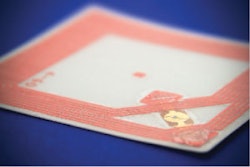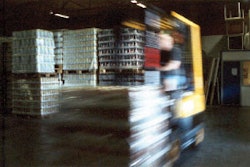Says wireless regulatory experience gives it an edge; solutions now in 39 countries on five continents
Vernon Hills, IL — February 15, 2006 — UHF radio frequency identification (RFID) printer/encoders from auto-ID solutions provider Zebra Technologies are now available for sale in 39 countries on five continents worldwide, making them the most widely available RFID printer/encoders, according to Zebra.
Zebra recently received regulatory approval from Taiwan and South Korea for its R4Mplus model. Additional approvals are pending in several more countries, which will bring Zebra's RFID printer/encoders to customers in most major markets globally, according to the solution provider.
UHF RFID regulations are not uniform around the world, and Zebra believes that this circumstance gives those solution providers with local market expertise a decided edge. Zebra said its own line of UHF RFID printer/encoders offers support for the latest EPC Gen2, EPC Class 1 and other prominent RFID protocols, in addition to the unique frequency bands, output power and other localized requirements.
Zebra asserts that it has an advantage in gaining regulatory approval for its RFID products. Bob Cornick, the company's vice president and general manager for RFID, said that the company's experience with mobile and wireless standards around the world gives the company insight and knowledge of local regulations and approval processes. "While others are scrambling to identify the government regulations in each market, we have been focused on localizing our RFID products and obtaining the necessary legal approvals," Cornick said.
The company also believes that its product provide an edge for its RFID customers in upgrading to the latest UHF standards. "Using software-defined radio architecture, Zebra has built-in flexibility for future protocols," the solution provider said.
"So far, all of the Gen2 chips are compatible with a single protocol type. However, future versions may add enhancements which could require updated reader firmware," said Cornick. "Last year we demonstrated how easily Zebra' s RFID printers can be updated, using a simple firmware download off the Internet, to accommodate new protocols, even to printers that had been purchased in late 2004."
The U.S. Department of Defense, Wal-Mart and other organizations are migrating to Gen 2 tagging requirements because it has performance advantages over previous-generation EPC technology. Gen 2 chips can be used around the world, have faster read rates, can offer more memory and are rewritable.
Additional Articles of Interest
— RFID technology has the potential to change the way supply chains are managed, but in order to be effective businesses need to take a holistic look at the deployment. Read more in the SDCExec.com article "Time for RFID: Applying RFID in the Supply Chain."
— For a contrary view of the future of the RFID market, see the article "The O'RFID Factor: A 'No Spin' Look at Where Radio Frequency Identification Is Headed," in the October/November 2004 issue of Supply & Demand Chain Executive.
Vernon Hills, IL — February 15, 2006 — UHF radio frequency identification (RFID) printer/encoders from auto-ID solutions provider Zebra Technologies are now available for sale in 39 countries on five continents worldwide, making them the most widely available RFID printer/encoders, according to Zebra.
Zebra recently received regulatory approval from Taiwan and South Korea for its R4Mplus model. Additional approvals are pending in several more countries, which will bring Zebra's RFID printer/encoders to customers in most major markets globally, according to the solution provider.
UHF RFID regulations are not uniform around the world, and Zebra believes that this circumstance gives those solution providers with local market expertise a decided edge. Zebra said its own line of UHF RFID printer/encoders offers support for the latest EPC Gen2, EPC Class 1 and other prominent RFID protocols, in addition to the unique frequency bands, output power and other localized requirements.
Zebra asserts that it has an advantage in gaining regulatory approval for its RFID products. Bob Cornick, the company's vice president and general manager for RFID, said that the company's experience with mobile and wireless standards around the world gives the company insight and knowledge of local regulations and approval processes. "While others are scrambling to identify the government regulations in each market, we have been focused on localizing our RFID products and obtaining the necessary legal approvals," Cornick said.
The company also believes that its product provide an edge for its RFID customers in upgrading to the latest UHF standards. "Using software-defined radio architecture, Zebra has built-in flexibility for future protocols," the solution provider said.
"So far, all of the Gen2 chips are compatible with a single protocol type. However, future versions may add enhancements which could require updated reader firmware," said Cornick. "Last year we demonstrated how easily Zebra' s RFID printers can be updated, using a simple firmware download off the Internet, to accommodate new protocols, even to printers that had been purchased in late 2004."
The U.S. Department of Defense, Wal-Mart and other organizations are migrating to Gen 2 tagging requirements because it has performance advantages over previous-generation EPC technology. Gen 2 chips can be used around the world, have faster read rates, can offer more memory and are rewritable.
Additional Articles of Interest
— RFID technology has the potential to change the way supply chains are managed, but in order to be effective businesses need to take a holistic look at the deployment. Read more in the SDCExec.com article "Time for RFID: Applying RFID in the Supply Chain."
— For a contrary view of the future of the RFID market, see the article "The O'RFID Factor: A 'No Spin' Look at Where Radio Frequency Identification Is Headed," in the October/November 2004 issue of Supply & Demand Chain Executive.
- More articles about Zebra Technologies.










